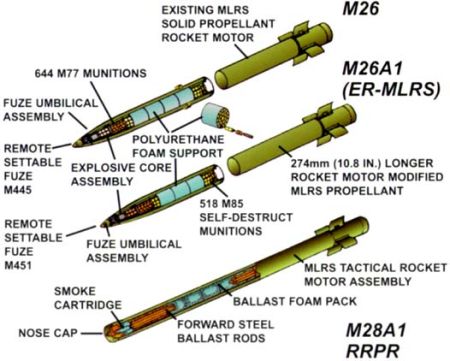Basic MLRS Rocket, M26
The first MLRS rocket was the unguided
M26 rocket. The M26 is spin-stabilized by 4 fins, has a range of 32 km (20 miles) and is armed with 644 M77 DPICM (Dual-Purpose Improved Conventional Munitions) anti-personnel/anti-materiel grenades. The M77 submunitions are dispensed over the target in mid-air, are drag-ribbon stabilized during free fall, and detonate on impact. The MLRS/M26 was first used operationally during Operation Desert Storm in 1991, where it acquired the nickname "steel rain".
The Extended Range MLRS Rocket (ER-MLRS) is a derivative of the M26 with a longer motor and only 518 grenades. This improves the range to more than 45 km (28 miles). The first ER-MLRS rocket was planned to be the
M26A1, which uses improved M85 DPICM submunitions. The original M77 has a relatively high dud rate (about 5%), and the M85 is a derivative with a self-destruct fuze to lower this rate significantly (< 1%). However, the development of the XM85 progressed slower than expected, and therefore the initial ER-MLRS rockets (first production contract was awarded in July 1996) were armed with M77 bomblets. The M77-equipped ER-MLRS is designated
M26A2. By 1999, the M85 grenade was ready for production, and the final 1200 of a total of about 4300 ER-MLRS rockets for the U.S. Army were built as M26A1.
MLRS Practice Rocket, M28
The
M28 is a training version of the M26, which replaces the warhead with steel ballast and three smoke canisters. The
M28A1 RRPR (Reduced Range Practice Rocket) is a derivative of the M28 with a blunt high-drag nose. This reduces the rocket's maximum range to 15 km (9 miles), making it suitable for use on smaller firing ranges.
Other MLRS Munitions (M27, M29, XM135)
The
M27 Trainer LP/C (Launch Pod/Container) is a completely inert electronic device to simulate a full load and launch sequence. The
XM29 was a rocket with SADARM (Sense and Destroy Armor) submunitions, while the
XM135 Binary Chemical Capability munition was intended for retaliatory chemical warfare. The XM135 contained two non-lethal agents, which were mixed after launch to form the deadly VX nerve agent. The XM29 and XM135 were developed in the late 1980s/early 1990s, but were apparently not procured for regular field use.
Guided MLRS Rocket, M30/M31
In 1994, the U.S. Army initiated the GMLRS (Guided MLRS) ATD (Advanced Technology Demonstration) program to develop a guided derivative of the M26 MLRS rocket. The
M30 GLMRS rocket uses a guidance system with an IMU (Inertial Measurement Unit) and a GPS receiver, and has four small additional control fins in the nose. To make full use of the much improved accuracy of the weapon over long distances, only 404 M85 DPICM bomblets are carried for a range of more than 60 km (37 miles). Minimum effective range for the GMLRS is about 10 km (6 miles). The first fully guided test launch of an
XM30 occurred in May 1998.
n late 1998, the GMLRS program entered a four-year SDD (Systems Development and Demonstration) phase, and the final production qualification tests were successfully completed in December 2002. In March 2003, the M30 GMLRS rocket was approved for low-rate initial production, and operational testing was completed in December 2004. The
XM31 is a variant of the M30 with a 90 kg (200 lb) unitary high-explosive warhead, which is currently in the SDD phase. So far, Lockheed Martin has received contracts for a production of more than 2500
GMLRS rockets, and the U.S. Army has plans to procure up to 100000 rounds.
In January 2006, the U.S. Army announced that the majority of (possibly all?) future purchases of tactical MLRS rockets will be M31s with unitary warhead. Production of the bomblet-equipped M30 will not be continued, because the dud rate of the M85 DPICM bomblets could not be brought below 1%.
http://www.designation-systems.net/dusrm/app4/mlrs.html



 ja sen taistelutekniikkamainen tukeminen tykistön tulella, eli että aiemmin käytännössä ilman kummempaa tilanteenanalisointia hyökkäysjoukon etenemisreittiä on ryhdytty mätkyttämään tykistöllä. Eli juu, tuossa suhteessa tuo meikäläisen linkkaus on ajastaan jäljessä. Koska siellä nimenomaan tuolla "hyökkäystyksitöllä" tuettiin Phaseline tyyppisesti joukkojen hyökkäystä melkein kuin taisteluteknisesti. Eli taktinen taso siirtyy entistä alemmalle tasolle.
ja sen taistelutekniikkamainen tukeminen tykistön tulella, eli että aiemmin käytännössä ilman kummempaa tilanteenanalisointia hyökkäysjoukon etenemisreittiä on ryhdytty mätkyttämään tykistöllä. Eli juu, tuossa suhteessa tuo meikäläisen linkkaus on ajastaan jäljessä. Koska siellä nimenomaan tuolla "hyökkäystyksitöllä" tuettiin Phaseline tyyppisesti joukkojen hyökkäystä melkein kuin taisteluteknisesti. Eli taktinen taso siirtyy entistä alemmalle tasolle. Toki meikäläisittäin sissitaktiikat, tai ns epäkoventionaaliset epälineaariset taistelutavat, astuvat mukaan kuvaan myös. Kuten tuolla sissitaktiikka ketjussa asiaa jauhettiin.
Toki meikäläisittäin sissitaktiikat, tai ns epäkoventionaaliset epälineaariset taistelutavat, astuvat mukaan kuvaan myös. Kuten tuolla sissitaktiikka ketjussa asiaa jauhettiin.